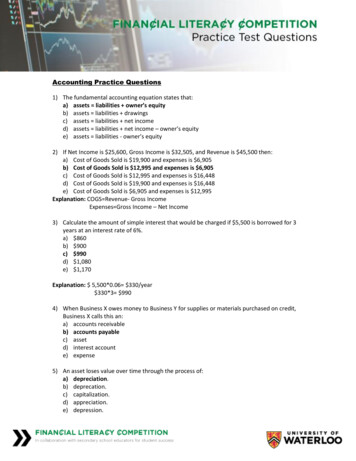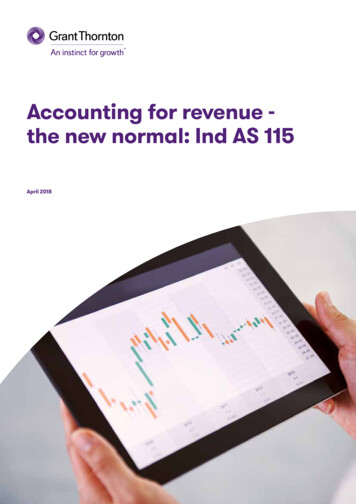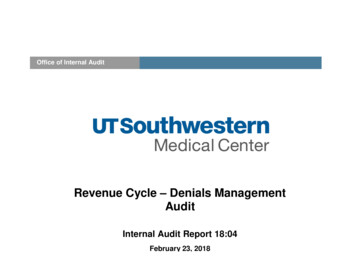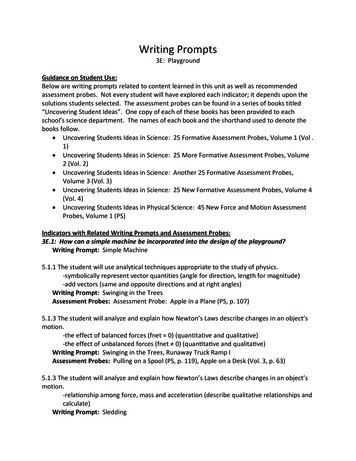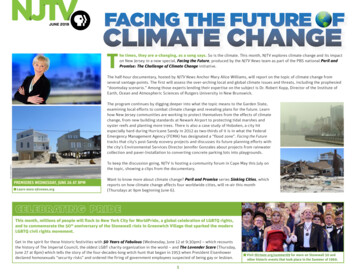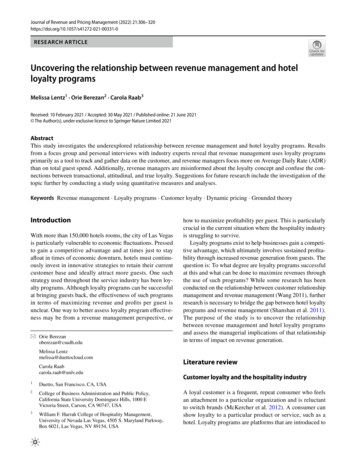
Transcription
Journal of Revenue and Pricing Management (2022) 31-0RESEARCH ARTICLEUncovering the relationship between revenue management and hotelloyalty programsMelissa Lentz1 · Orie Berezan2 · Carola Raab3Received: 10 February 2021 / Accepted: 30 May 2021 / Published online: 21 June 2021 The Author(s), under exclusive licence to Springer Nature Limited 2021AbstractThis study investigates the underexplored relationship between revenue management and hotel loyalty programs. Resultsfrom a focus group and personal interviews with industry experts reveal that revenue management uses loyalty programsprimarily as a tool to track and gather data on the customer, and revenue managers focus more on Average Daily Rate (ADR)than on total guest spend. Additionally, revenue managers are misinformed about the loyalty concept and confuse the connections between transactional, attitudinal, and true loyalty. Suggestions for future research include the investigation of thetopic further by conducting a study using quantitative measures and analyses.Keywords Revenue management · Loyalty programs · Customer loyalty · Dynamic pricing · Grounded theoryIntroductionWith more than 150,000 hotels rooms, the city of Las Vegasis particularly vulnerable to economic fluctuations. Pressedto gain a competitive advantage and at times just to stayafloat in times of economic downturn, hotels must continuously invest in innovative strategies to retain their currentcustomer base and ideally attract more guests. One suchstrategy used throughout the service industry has been loyalty programs. Although loyalty programs can be successfulat bringing guests back, the effectiveness of such programsin terms of maximizing revenue and profits per guest isunclear. One way to better assess loyalty program effectiveness may be from a revenue management perspective, or* Orie Berezanoberezan@csudh.eduMelissa Lentzmelissa@duettocloud.comCarola Raabcarola.raab@unlv.edu1Duetto, San Francisco, CA, USA2College of Business Administration and Public Policy,California State University Dominguez Hills, 1000 EVictoria Street, Carson, CA 90747, USA3William F. Harrah College of Hospitality Management,University of Nevada Las Vegas, 4505 S. Maryland Parkway,Box 6021, Las Vegas, NV 89154, USAVol:.(1234567890)how to maximize profitability per guest. This is particularlycrucial in the current situation where the hospitality industryis struggling to survive.Loyalty programs exist to help businesses gain a competitive advantage, which ultimately involves sustained profitability through increased revenue generation from guests. Thequestion is: To what degree are loyalty programs successfulat this and what can be done to maximize revenues throughthe use of such programs? While some research has beenconducted on the relationship between customer relationshipmanagement and revenue management (Wang 2011), furtherresearch is necessary to bridge the gap between hotel loyaltyprograms and revenue management (Shanshan et al. 2011).The purpose of the study is to uncover the relationshipbetween revenue management and hotel loyalty programsand assess the managerial implications of that relationshipin terms of impact on revenue generation.Literature reviewCustomer loyalty and the hospitality industryA loyal customer is a frequent, repeat consumer who feelsan attachment to a particular organization and is reluctantto switch brands (McKercher et al. 2012). A consumer canshow loyalty to a particular product or service, such as ahotel. Loyalty programs are platforms that are introduced to
Uncovering the relationship between revenue management and hotel loyalty programs build consumer loyalty through an arranged reward systembased on a consumer’s history (Yi and Jeon 2003; Haley2006). Loyalty programs can be considered value-sharinginstruments (Yi and Jeon 2003), which lead to an increasein value perception, overall improving customer retention(Berezan et al. 2013; Woodruff 1997). Almost every firm inthe hospitality industry has developed some type of loyaltyprogram for their guests. Loyalty programs may also havea tiered structure that incentivizes customers to advance intiers through spending (Tanford 2013) and creates welldefined classes to aid patrons in understanding what benefitsthey are able to acquire (Drèze and Nunes 2009).Previous research established that a firm with a 5%increase in loyalty could produce profit increases of 25–85%(Reichheld and Sasser 1990). An increase of that magnitudemakes it crucial for companies to participate in loyalty programs. However, there is a lack of research on the feasibilityof loyalty programs and a solid basis for profit growth fromloyalty has not yet been established. Berezan et al. (2013)suggest that management needs to track whether loyalty program practices lead to the desired true loyalty, or merely ashort-term behavioral impact. In terms of impacting hotelbooking behavior, numerous factors have been shown to besignificantly more important than loyalty program offerings,including value for money, quiet/soundproofed rooms, positive referral from friends, proximity to tourist attractions,and décor (Berezan et al. 2015). Dowling (2002) states thatsuch programs are neither cost effective nor foster true loyalty. Regardless of their effectiveness, loyalty programs arenow considered by customers as an expected part of thebrand experience and require a constantly evolving strategyin order to be competitive (Tanford et al. 2016; Yoo et al.2018).To maximize loyalty, customers need to possess high levels of both behavioral and attitudinal loyalty, or true loyalty(Tanford and Baloglu 2013). It is paramount to differentiatetrue loyalty from repeat purchasing (Han et al. 2011; Hanand Hyun 2012). Behavioral loyalty focuses on repeat purchases and not the psychological decision processes associated. Han and Hyun (2012) also discussed the elevated number of individuals with multiple memberships to customerfrequency programs, therefore, not displaying true loyalty.Despite the increased memberships, repeat purchases aloneare usually not enough to ensure customers’ positive attitudes toward a product/service (Shoemaker and Lewis 1999;Bowen and Chen 2001; Han and Hyun 2012). Long et al.(2003) also recognized that frequency programs are a widelyused method of relationship marketing. They also noted thatthese programs only increase short-term profitability andoften fail to attain these customers long term.Furthermore, hotels have several revenue centers, such asrooms, food and beverage, casino, spa, entertainment, nightlife, and golf if applicable (Ivanov and Zhechev 2012). Due307to the inability to directly measure the impact of loyalty onrevenue, it is difficult to determine if in fact, hotel loyaltyprograms could also be considered revenue generators forhotels.Measuring customer loyaltyPrior research has not fully explored methods for measuringconsumer loyalty or loyalty program success (Aksoy 2013).Historically, managers have used several different measuresto track consumer loyalty, such as customer satisfaction(Kandampully and Suhartanto 2003) or customer retention (Bowen and Shoemaker 2003). Over time, one singlemethod or measure has not emerged as an industry standard for tracking or measuring consumer loyalty. This posesinteresting questions regarding the actual measurements ofloyalty programs.A method introduced in the 1980’s by Raju was a multiple question version of a Likert scale to attempt to measurethe degree to which people exhibited loyalty (Raju 1980).Further, Lichtenstein et al. (1990) modified the scale to havefewer questions and incorporate the behavioral aspect ofconsumer loyalty. These scales were measuring the likelihood that the consumer would stay with their current product over purchasing a new one (Raju 1980), however, asexplained in Shoemaker and Lewis (1999), purchase behavior alone is not sufficient to measure loyalty. As indicatedby Oliver (1999), loyalty is a behavioral construct consistingof various cognitive and attitudinal factors. The level of difficulty in developing a method to measure loyalty may be apossible reason as to why no standard method exists.Kandampully and Suhartanto (2003) explain that thereis no standard definition for loyalty and explore the idea of“service loyalty” further, by describing a loyal consumer ofthe service industry as one who repeats business at a firmand also recommends the firm to others. A loyal consumer’swillingness to recommend the brand/service to others is acrucial aspect of loyalty for businesses (Bowen and Shoemaker 2003). This solidifies the importance of developing adefinition for loyalty and a metric with which to measure it.Bolton et al. (2000) suggest that evidence must be gathered to quantify a program’s effect on a customer’s repurchase intentions. A loyal guest will frequent a brand over aperiod of time, so the metric must be able to quantify theactions over that period. In another article, Bolton et al.(2000) warn that repurchase intentions must be analyzedcarefully due to the relationship between a customer’s priorattitude and repurchase intention. This notion possible suggests that a customer may or may not decide to patronize abrand due to their prior negative attitude at that moment.Further, some research has indicated that repurchasing isnot a measurement of loyalty because the act of repurchasingshould be intentional (Tepeci 1999).
308Mattila (2001, 2004) used a variety of scales to measureconsumer loyalty during service failures. The author adapteda version of the Loyalty Scale, developed by Zeithaml,Berry, and Parasuraman (1996, cited in Mattila, 2001),which helped identify behavioral intentions of the participants. The results of the study indicated that loyal consumersmight have more realistic or rational expectations in relation to service failures (Mattila 2001). Further, in anotherstudy, Matilla utilized the affective commitment scale, whichexamined emotional attachment to the brand, as well as theloyalty scale that explained word-of-mouth behavior andrepurchase intention (Mattila 2004). The study indicatedthat those with stronger emotional attachments were lesslikely to be deterred from repurchasing by a service failure.In an article by Baloglu (2002), the author utilized a Likert scale to measure behavioral and attitudinal characteristicsof loyalty in a questionnaire. The author used this loyaltyscale to show the different levels of loyalty among consumers, from a low to very strong commitment (Baloglu 2002).Sui and Baloglu (2003) continued to examine the role ofan emotional attachment as it related to loyalty in casinos.The authors explored the role of trust and switching costs,and what effect those antecedents had on emotional attachment. The use of Likert scale in the study aided the authorin adding to the previous research; the article concluded thatcasinos should be focusing on increasing trust in loyal consumers, as well as making switching costs higher, to detertheir loyal guests from leaving that casino (Sui and Baloglu2003).Research Question 1: How can the financial impact ofloyalty programs be determined ifthe current scales solely measureloyalty type?Building consumer loyaltyConsumer loyalty is comprised of various dimensions andthe reasoning behind a customer’s loyalty will vary witheach person and service (Taylor et al. 2006). Oliver (1999, p.34) defines customer loyalty as “a deeply held commitmentto rebuy or re-patronize a preferred product/service consistently in the future.” He also indicates that loyalty can occurat multiple levels, such as cognitive and behavioral.Research addressing cognitive and behavioral dimensions of loyalty (Baloglu 2002; Mattila 2006; Shoemakerand Lewis 1999; Tanford 2013) has continued to increase inrecent years. Shoemaker and Lewis (1999) were the first torecognize a demand to research attitudinal aspects of loyalty.Recently, there has been an emphasis on the attitudinal component of trust and commitment (Mattila 2006; Morgan andHunt 1994 cited in Tanford 2013) in the loyalty literature(Tanford 2013).M. Lentz et al.Behavioral loyalty involves the purchasing behavior ofa product or service over a period of time (Bowen andShoemaker 2003). It is vital to many businesses becauseit involves the literal act of purchasing the service or product, without which there would be no revenue. An aspectof behavioral loyalty incudes this decision to chooseone brand over another (Baloglu, 2002; Mattila 2006)when making purchases. Tanford (2013) indicates that inresearching behavioral loyalty, the actual behavior cannot always be observed; researchers can also use behaviorintention. However, Shoemaker and Lewis (1999) arguethat purchase behavior is not sufficient as an indicator forloyalty because it does not discuss motivation for the purchase. Hotels will experience increased business if moreguests stay and make purchases at their hotel; however,some indicate (Mattila 2006; Bowen and Shoemaker 2003;Tanford 2013) that it is more important for customers tohave a connection to the brand or hotel.Vence (2002) describes transactional marketing as the“go-to” method for marketing in hospitality. The authorstates that although relationship marketing is on the rise,firms will still revert to traditional transactional marketing,which only short-term drives sales (Osman et al. 2009).Firms will still benefit from transactional marketing andbehavioral loyalty due to the increased revenues; however,as indicated by Osman et al. (2009), it is only in the shortterm.The shift from the classic approach to marketing to thecustomer-focused approach has brought about a newfoundimportance of loyalty in hospitality firms (Crie 2004).Hospitality firms now consider all aspects of the customer.Some studies have used frequency of visits (Baloglu 2002;Crie 2004; Tanford 2013) as a basis for analyzing behavioral loyalty. Baloglu (2002) examined the proportion ofvisits to a particular casino as a measure of loyalty, andTanford (2013) also concluded that percentage of visits,not only frequency, should be included in the analysis ofbehavioral loyalty.Attitudinal loyalty includes a customer’s intentions andpreferences (Gremler and Brown 1997 cited in Kandampully and Suhartanto 2003). This aspect of loyalty is considered very important because a consumer is more thana transaction or purchase and a consumer with attitudinalloyalty may also have higher behavioral intentions such asrepurchase intentions (Mattila 2006). Bowen and Shoemaker(2003) stress the importance of an emotional connectionin consumer loyalty. Loyalty is more than customer satisfaction. Kandampully and Suhartanto (2003) examine theexisting relationship between satisfaction and loyalty andacknowledge that they are not the same. Satisfaction is considered pleasurable fulfillment (Oliver 1999) and occurs asa customer consumes an item or service, which can lead topleasure/displeasure.
Uncovering the relationship between revenue management and hotel loyalty programs Research Question 2: How do loyalty programs addressemotional connection to the brand(attitudinal loyalty) and repeatvisits/purchases (transactionalloyalty)?A cost perspective of loyalty programsResearch has indicated that consumers are drawn to thoseloyalty programs that differentiate themselves from others(Chen and Hitt 2006; McCall and Voorhees 2010). Thisrequires constant attention and development to remainattractive to a diverse customer base in addition to theinvestment in establishing and maintaining the programs.Hanson et al. (2008) described how loyalty programexpenses are a subset of sales and marketing expenses,which are one of the largest expenses for a hotel on average. These hotels are paying for the benefits provided totheir customers to encourage repeat patronage, which isoften in the millions (McCleary and Weaver 1991; Shanshan et al. 2011). Although it is much more expensive toacquire a new customer than to retain an existing one,previous research (Berman 2006; Xie and Chen 2013) discusses circumstances in which loyal customers may haveto be additionally compensated when expected rewardsare not delivered thereby further adding to the cost of theprogram.Loyal consumers are thought to be less price sensitiveover time and, therefore, cost less to retain than non-loyalconsumers, ultimately reduce marketing and advertisingexpenses (Bowen and Shoemaker 2003). Tanford et al.(2011) discussed a cost of loyalty programs to the customer in addition to their financial purchase: switchingcosts. Switching costs are costs associated when changingfrom one brand to another (Bowen and Shoemaker 2003).Switching costs may involve monetary (Han et al. 2011)costs, such as loss of funds or points redemption, or nonmonetary switching costs, such as loss of relationship (Tanford et al. 2011). Switching costs are important deterrents ofexit among members in higher tiers (Shoemaker and Lewis1999). Loyalty programs that can keep their switching costshigh will have less trouble retaining their members.Research indicates a gap between hotel loyalty programsand profitability (Shanshan et al. 2011). Loyal members arerewarded for their continued patronage but at a cost to thehotel. Higher tiered loyalty members receive more expensive benefits at higher costs to the hotel (Tanford 2013).Therefore, although marketing and advertising expensesmay be reduced based on price sensitivity (Bowen and Shoemaker 2003), the hotel will still incur larger expenses dueto their higher tiered members receiving expensive benefits(Tanford 2013).309Research Questions 3: How does charging differentcustomers’ different prices forthe same room at the same hotelimpact consumer loyalty?Research Question 4: How do revenue managers viewthe financial expense of loyaltyprograms?Loyalty from the revenue management perspectiveLoyalty has been considered from sales and marketing perspectives (Tepeci 1999; Hanson et al. 2008; Vence 2002),financial perspectives (McCleary and Weaver 1991; Shanshan et al. 2011), as well as an internal perspective of structure (Tanford 2013; Tanford et al. 2011; Drèze and Nunes2009). The dilemma of loyalty programs seems to be thatthey are a large expense and less incremental revenue forhotels than expected. Loyalty from a revenue managementperspective (Shoemaker 2003) appears to be a relationshipthat has not been fully explored but could possibly shed lighton the connection between hotel loyalty programs and revenue management practices.Revenue management is an essential instrument formatching supply and demand by segmenting customersbased on their purchase intentions and assigning them ina way that will maximize the firm’s revenues (Ivanov andZhechev 2012). Revenue management has been a topicof interest in the world of academia for many years (Tseand Poon 2012), with topics such as pricing (Shoemaker2003, 2005), price fairness (Kimes and Rohlfs 2007; Kimesand Taylor 2010; Kimes and Wirtz 2007), decision framing (Tversky and Kahneman 1981), as well as its impacton consumers (Choi and Mattila 2004; Heo and Lee 2010).Yield management has had profound effects on capacityconstrained industries by aiding them in their forecastingand anticipating supply and demand (Heo and Lee 2010).Shoemaker (2005) discusses the practices of revenuemanagement in hotels and its effects on consumer loyaltyand suggests that that revenue management techniques candecrease trust and loyalty. Noone et al. (2003) propose thatusing revenue management and customer relationship management cooperatively, will allow pricing to consider thelifetime value of the customer and not just simply base it ondemand. This notion is confirmed by Mathies and Gudergan(2007) who recognize the need to integrate revenue management and customer centric marketing. Kimes (1989) contended that pricing strategies used in revenue managementcould alienate a portion of the customer base. Therefore,hotels have much to consider when using revenue management pricing strategies that may concern or impact theirloyal customers.Research Question 5: What is the overall relationshipbetween revenue management and hotel loyalty programs?
310MethodologyTo better understand the relationship between revenuemanagement and hotel loyalty programs, this study firstconducted a focus group of revenue management expertsfrom across the U.S. Next, in-depth interviews were conducted with revenue managers from several Las Vegasproperties.Focus GroupA focus group is performed by initiating a planned discussion with a small group of people and led by a moderator (O’Neill 2012). In this form of qualitative research,the participants of the focus group will interact with oneanother. According to O’Neill (2012), focus groups area useful tool because they add a social context to theresearch. As Morgan (1997) explained, focus groups canoften serve as the primary means of collecting qualitativedata.A focus group was conducted as part 1 of this exploratory research. The group consisted of eight revenue management experts from hotel properties across the U.S. andthe discussion lasted for one hour. A list of seven questionswas created for the focus group (Appendix 1), with eachquestion having key words or additional talking pointslisted for the moderator. The responses from the participants were recorded, transcribed, and used to identifyemergent themes and relationships and ultimately construct interview questions for the next portion of the study.In‑Depth InterviewsThe second part of this study consisted of in-depth personal interviews with revenue managers from hotels inLas Vegas. Marshall et al. (2013), describes how interviews are another increasingly popular form of qualitativeresearch. According to Webb (1995), in-depth interviewsare personal encounters that entail consistent probingof the participant to speak freely and express beliefs oropinions on a certain topic. This has a similar advantageto the focus group in that it adds the social element tothe research, which may elicit additional information notavailable without the researcher present and interactingwith the participant.Hanson and Grimmer (2007) stated that in-depth interviews are an important and proficient tool for qualitative research and are the most frequently used method inqualitative research. In-depth interviews can feature openor closed ended questions, with a specific, overarchingM. Lentz et al.subject or research question in mind (Kwortnik 2003).Raab et al. (2018) conducted in person interviews toexplore the often-strained relationships between onlinetravel agents and hotel revenue management professionals.A general interview guide approach (Turner 2010) wasused for all interviews. The interviews each consisted ofeight questions (Appendix 2) that were based upon theresults and conclusions drawn from the focus group in part1 of the study. Beyond the prescribed interview questions,the interviewer probed participants for to gain a richer perspective of their experience.13 personal interviews were conducted, which lasted from45 to 60 min per interview. The sample chosen for the indepth interviews did not participate in the focus group. Allparticipants in the interview were all revenue managementprofessionals, both men and women, currently employed inthe hospitality industry. The sample participants had an average of 4 years working in the hospitality industry, includinghotels and hotel casino properties. The sample participantswere hand selected by the researcher for their knowledge ofthe industry and current trends, as well as their experiencewith and interest in the topic of revenue management andhotel loyalty programs.Content analysisContent analysis is a useful technique to researchers whoare attempting to identify patterns, frequencies, or potentialcategories within another subject (Carlson 2008). This studyapplied the Grounded Theory approach by which an explanatory framework will be discovered which is grounded inthe data. This method does not follow established theoriesbut discovers explanatory frameworks for theories fromthe examined data (Starks and Trinidad 2007). The useof ATLASti5 allowed for the interviews to be dissectedusing content analysis. Content analysis is a useful tool forexamining trends and patterns within documents (Stemler2001). The transcripts from the interviews were processedusing ATLASti5, allowing them to be coded, analyzed,and searched for potential categories. The content analysisincluded three phases: 1) identifying codes within categories; 2) relating codes to one another to identify emergentthemes; and 3) constructing a theoretical model that detailsperspectives of strategic relationships with hotel revenuemanagers, and identifying new patterns and categories associated with those relationships.In this study, 3 researchers conducted content analysis onthe interview transcripts and coded keywords and phrasesthat resulted in emergent themes and relationships. Toenhance inter-rater reliability, the interview transcripts werecoded by each researcher individually first and then codedagain as a group. According to an article by Tierney andClemens (2011), trustworthiness depends on four factors:
Uncovering the relationship between revenue management and hotel loyalty programs credibility, transferability, dependability, and conformability. The researcher attempted to exemplify the methods andresearch design clearly, as well as present the results in a waythat illustrate credibility and conformability.ResultsInterview responsesThe first question concerned the financial aspect of loyaltyprograms. All thirteen of the respondents stated that theydo consider the financial impact of loyalty programs. Nineof the thirteen respondents indicated that tracking guestbehavior is the primary method for understanding the financial impact of the loyalty program; tracking guest behaviorallowed them to incentivize the guest to return and maximizerevenue. Four of the respondents indicated that the financialimpact of loyalty programs was measured by consideringgaming contributions per loyalty program member and theprofitability (or loss) of promotions offered to members.The second research question explored how loyalty programs generate emotional connection to the brand (attitudinal loyalty) and/or repeat visits/purchases (transactionalloyalty). Five participants conveyed that a loyalty programis primarily concerned with transactional loyalty and theprimary concern is acquiring data on the guest, and that anemotional connection to the brand results from the guest’sefforts, not the hotels. Seven participants articulated thenecessity of an emotional connection and felt that hotelsshould strive for making that emotional connection withtheir guests. However, these participants explained that theirmethods for loyalty marketing were purely transactional.One participant stated that they work closely with their customer relationship management team and encourage theirstaff to make personal connections with guests.The third research question considered how the revenuemanagement practice of charging customers different pricesfor the same room at the same hotel impacts consumer loyalty. Two participants contended that price sensitive guestsare usually not loyal, and therefore, it has little effect. Threeparticipants stated that dynamic pricing can increase loyalty because guests are given the chance to receive exclusiveoffers and discounts not normally available to them. Twoof the participants explicitly stated that it should have little to no impact if there is rate parity among channels. Theremaining participants indicated that due to accessibility andavailability of information, guests were very aware of supply/demand and how that affects room prices on rooms and,therefore, had a minimal effect on loyalty.The fourth research question inquired about revenue managers’ concerns of the expense of loyalty programs. Fourparticipants explained that they were concerned with the311reinvestment levels in a guest. Two of the participants mentioned how they were alarmed about the number of redemption reservations in house at one time. Four participantsstated that there were specific positions created to handle theloyalty program finances, while revenue management wasmainly concerned with the data. Two participants respondedthat revenue management was strictly involved with revenuegeneration, while the last participant stated that it dependedon the size of a company.The fifth research question dealt with the overall interaction between revenue management and hotel loyalty programs. Two participants stated that revenue management’sinvolvement in the loyalty program is sufficient the way itis; revenue management works a little with marketing toyield rates to loyal member segments. Three participantsindicated that an intermediary between revenue managementand hotel loyalty programs way the best way to operate. Atlast, eight participants explained that revenue managementshould have more direct involvement with loyalty programsto be successful, and that hotels should strive for a total hotelrevenue management approach.Codes, subcategories, and emergent themesContent analysis was conducted on the interview responsesresulting in codes, subcategories, and emergent core categories (themes), as summarized in Table 1.After coding the interview data, a thematic analysis wasperformed by relating the codes to one another into subcategories, then further grouping the subcategories into resulting emergent themes. Several themes emerged from the dataduring analysis: goal is to understand the consumer; strategyis at the core of revenue management; the smart consumer,data; and striving for emotional connection through transactional loyalty.Goal is to understand the consumerThe overall goal of understanding the consumer and theirbehavior was mentioned several times by
2 College of Business Administration and Public Policy, California State University Dominguez Hills, 1000 E Victoria Street, Carson, CA 90747, USA 3 William F. Harrah College of . NV 89154, USA. Uncovering the relationship between revenue management and hotel loyalty programs 307 build consumer loyalty through an arranged reward system .






